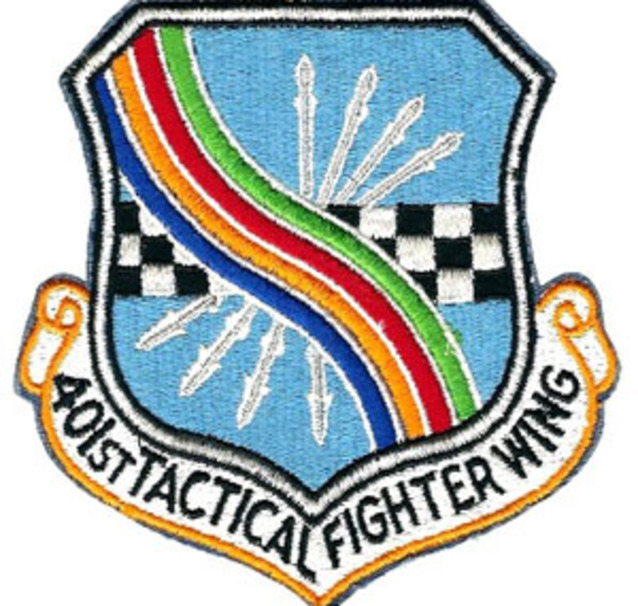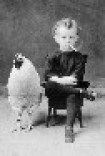
HISTORY OF THE 401st TACTICAL FIGHTER WING
HeThe 401st Tactical Fighter Wing traces its proud heritage to the 401st Bombardment Group (Heavy), a World War I1 combat unit. Upon its activation at Ephrata Army Air Base, Washington, on 1 April 1943, the Group was comprised of the 612th, 613th, 614th and 615th Bombardment Squadrons (~eavy). With the arrival of B-17G aircraft at Ephrata AAB, the Group received orders to transfer to Geiger Field, Washington, on 15 June 1943, for aircraft familiarization training. Shortly thereafter (on 8 July) , the unit again transferred; this time to Great Falls Army Air Base, Montana. There the Group received advanced combat training. The air element of the Group eventually deployed to Deenethorpe, England, via Newfoundland and Scotland, on 19 October 1943. Having made the transatlantic voyage on the Queen Mary, the ground element arrived on location on 3 November 1943. After reuniting the forces and under the command of Eighth Air Force, the Group immediately began preparations for combat missions. Their first combat action was seen on 26 November 1943 when the 401st Bombardment Group B-17Gs flew a full strength raid on Bremen, Germany. The aircrews were forced to employ radar techniques during the operation since heavy overcast precluded visual bombing of the target. The Bremen raid was the first in a series of attacks against targets in France, Germany, Holland, and Luxembourg, composed primarily of port installations, submarine pens, V-1 and V-2 rocket sites, factories, power stations, airfields, oil refineries, and coastal gun batteries. On 11 January 1944, the Group won its first Distinguished Unit Citation for its part in a major attack on Oschersleben, Germany, near Berlin. A second citation was earned for a raid on the Erla Maschinewerk aircraft assembly plant in Leipzig on 20 February 1944. The Group, having encountered heavy flak, pressed on to deliver its bombs within 1000 feet of the aiming point and brought plant operations to a halt. After a long series of attacks on Berlin and the surrounding area, the Group was diverted to bombing coastal gun batteries and road and rail choke points in the Normandy region of France in preparation for the D-Day invasion. Combat activity on the day of the invasion included bombing of fortifications within 1000 yards of the landing beaches five minutes before the first troops waded ashore. During the next several months, the 401st Bomb Group supported operations to aid the breakthrough at Saint Lo in July, the Siege of Brest in August, and an airborne attack on Holland in September, concentrating on oil reserve sites. During the Battle of the Bulge, December 1944 to January 1945, the unit flew missions against transportation targets and communications centers in the battle area and supported an airborne attack across the Rhine River in March 1945. The final combat mission came on 20 April 1945 when 401st aircrews bombed Brandenburg marshalling yard. The 401st Bomb Group returned to the United States on 30 May 1945 with the ground element again traveling by oceanliner; this time aboard the Queen Elizabeth. The Group reported to Sioux Falls Army Air Field, South Dakota, and began training for conversion to B-29 aircraft. The rush to lay down arms after V-J Day brought about the deactivation of the unit on 28 August 1945. After World War 11, the 401st was redesignated the 401st Bombardment Group (Very Heavy), and assigned to reserve status at Brooks Field, Texas. The redesignation and reactivation took place on 26 June 1947. The active reserve 401st was further redesignated the 401st Bombardment Group (Medium) and, as a reserve unit, flew AT-6, AT-11, B-26, B-29, and B-50 aircraft during the ensuing three year period. While stationed in Texas, the 401st flew various training exercises and eventually became part of the Strategic Air Command (SAC) after being recalled to active service on 1 May 1951. A month later, on 25 June, the 401st Bomb Group's short term active service was temporarily interrupted with yet another inactivation order. Upon reactivation on 8 February 1954, the Group was renamed the 401st Fighter Bomber Group and found itself at a new home -- ~lexandria AFB, ~ouisiana. During its tenure at Alexandria, the Group was assigned to the 366th Fighter Bomber Wing (FBW), Tactical Air Command (TAC) , and equipped with F-86 aircraft. For the first three years of its existence with the 366 FBW, the 401st, composed of the 612th, 613th and 614th Fighter-Bomber Squadrons, trained in tactical operations and participated in maneuvering demonstrations in the United States and Europe. A year after the unit arrived at Alexandria AFB, the Group transferred all assigned F-86 aircraft to McClellan AFB, California, and began conversion to an older model (F-84) fighter aircraft. The F-84 brought stardom to the 401st when the 613th and 614th bombers participated in a Warner Brothers presentation, "The McConnell Story". From 10 January until 10 February 1955, the 613th and 614th FBSs flew a total of 125 sorties using eight assigned F-84 aircraft. The aircraft were painted blue with MIG-15 markings to simulate enemy aircraft during the Korean conflict. Approximately 85 percent of all 401st pilots participated in the aerial combat scenes. While stationed at Alexandria AFB, the 401st Fighter Bomber Group's primary mission was pro-iding a tactical squadron for a six month deployment to Europe, In June 1956, the 401st once again became an F-86 unit with the famous F-84 aircraft assigned to an Air National Guard unit. Two years later, the Group transitioned to more sophisticated F-100D fighter aircraft. The historic conversion began on 30 June 1957 with 57 F-100s assigned from Bunker Hill AFB, Indiana, Although the 401st Fighter Bomber Wing was constituted on 23 March 1953, it was not activated until 25 September 1957. Redesignation as the 401st Tactical Fighter Wing came on 1 July 1958, with the history and honors of all previously related 401 TFW, another squadron, the 615 TFS, was assigned and activated the same day. When the 401st was reassigned to England AFB (previously Alexandria AFB) it became the sister wing to the 366th Fighter Bomber Wing under the 834th Air Division, Tactical Air Command (TAC) . From 1957 - 1966, the 401st participated in various events and demonstrations while stationed at England AFB. In March 1958, four aircrews of the 615 FBS set an Air Force precedent when they flew their F-100s non-stop from Langley AFB, Virginia, to Chaumont AB, France. Later in the same month, Captain H.P. Phillips led a flight of F-100Ds on the same route in a record breaking time of seven hours and thirteen minutes. For the period 1 January through 31 December 1963, the wing received an Outstanding Unit Award for exceptionally meritorious service in "contributing to the success of many joint service exercises, North Atlantic Treaty Organization (NATO) rotations and firepower demonstrations." In February 1964, the tactical units of the 401st assumed rotational duties at Clark AB, Philippines, and were tasked to perform combat strike roles at Da Nang and Bien Hoa Air Bases, Republic of Vietnam; Takhli AB, Thiland; and Tainan AB, Taiwan. On 19 November, the wing assumed operational control over the 90th Tactical Fighter Squadron at England AFB and, eight days later, the 612 TFS moved to Misawa AB, Japan. The last major organizational change of the year came when the wing acquired another squadron, the 531 TFS, on 19 November 1964. The wing eventually settled at its present location, Torrejon Air Base, Spain, on 27 April 1966. Concurrent with the move, the wing lost the 614th and 615th TFSs to the 834th Air Division at England AFB, and picked up the 307th and 353rd TFSs. Shortly after its arrival at Torrejon AB, the wing assumed host unit duties and began rotating forces to other European and Near Eastern locations on special weapons alert duty and in support of NATO, USAF, and Spanish Air Defense Command exercises. In 1970, the wing converted to newer F-4E Phantom I1 aircraft and, a year later, experienced another major reorganization when the 353rd and 307th TFSs were relocated stateside at Myrtle Beach AFB; the wing, in turn, regained the 612th and 614th TFSs from duty at Phan Rang AB, Vietnam. The numerical realignment resulted in the wing being arranged as it had been when first activated in 1943, less the 615 TFS. During 1973, the wing again changed aircraft, this time to F-4C models. The change, to older but still highly capable aircraft, resulted in the wing flying F-4Cs until the changeover to more advanced F-4Ds in 1978. While in Spain, the wing has intensively pursued the highest degree of readiness, given the extremely challenging responsibility of being the only operational USAF aircraft asset in Europe's southern region. Throughout its tenure at Torrejon AB, the 401st participated in numerous regional exercises such as Shabaz, a CENT0 exercise held in Iran before the revolution; National Week, a naval exercise conducted near Sigonella, Italy; Datex, a joint French/US training exercise; and many other NATO sponsored events that included the intensive annual Display Determination series of deployment exercises held in the Mediterranean area. In addition, joint training with the Spanish Air Force has provided both U.S. and ~panish aircrews with excellent training opportunities and helped to develop the high degree of friendship and cooperation enjoyed today. In early 1983, the 401st Tactical Fighter Wing opened a new and exciting chapter in its distinguished history. The acquisition of advanced technology F-16 fighter aircraft, which replaced the wing's venerable F-4D Phantom IIs, added new dimensions and versatility to the wing's mission capability. The 401st was declared fully operational in its F-16 fighter commitment on 1 January 1985. During the forty two years of existence, the 401st ~actical Fighter Wing changed names, aircraft, locations, and missions; yet, throughout its history, one element has remained consistent; the people. Never less than totally dedicated, hard working, and vigilant, the members of the 401st Tactical Fighter Wing, and its predecessors, provided the driving force behind the unit's many achievements. They built a proud past--and assure an equally proud future.


